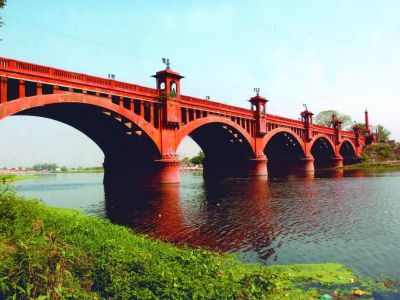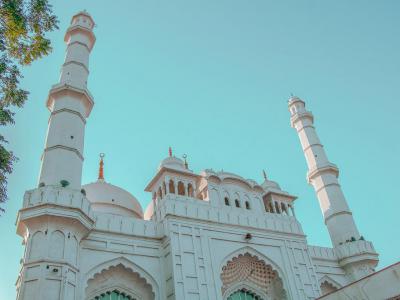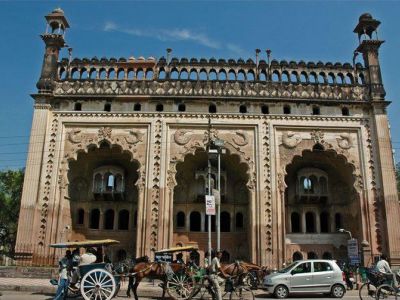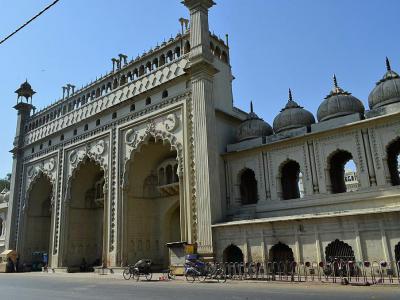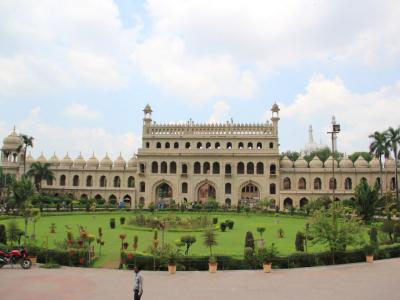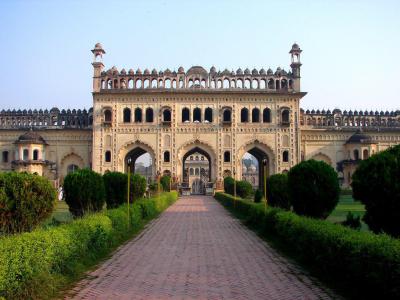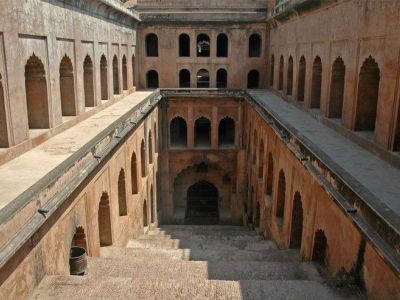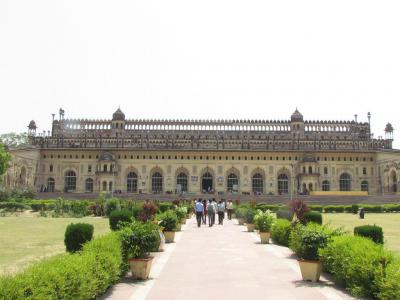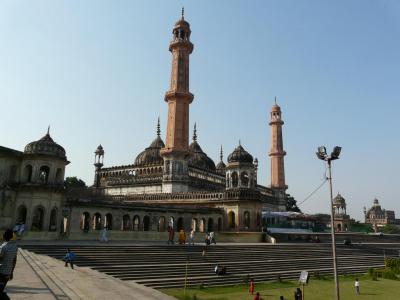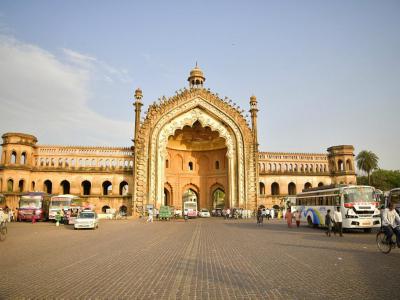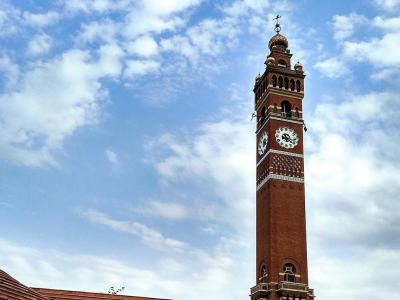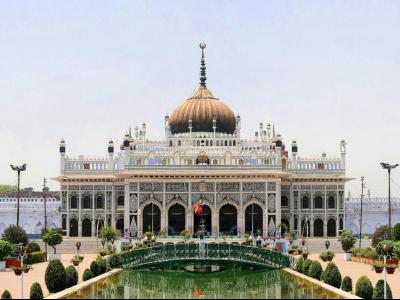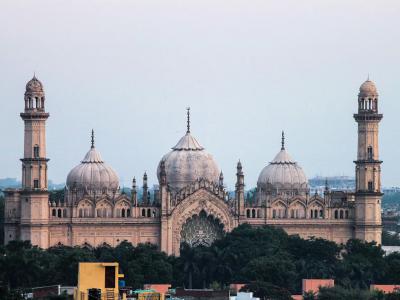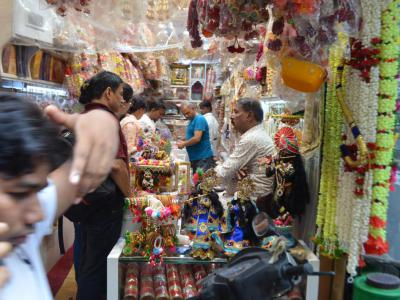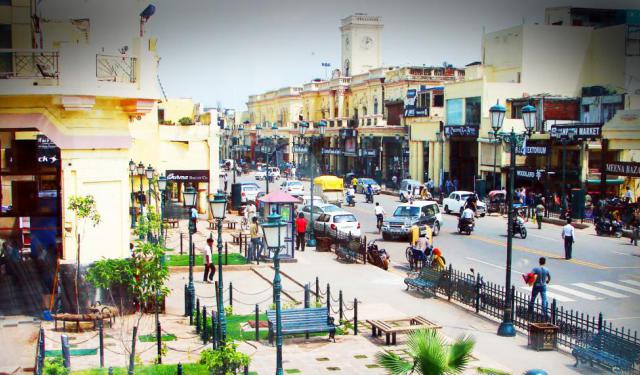Lucknow Introduction Walking Tour (Self Guided), Lucknow
The capital city of the Indian state of Uttar Pradesh, Lucknow, is one of the country's most popular tourist destinations. It owes its popularity largely to the rich architectural, cultural and historic heritage.
In the 14th century, Lucknow was the capital of the Awadh region. Starting from 1350, both the city and some parts of the region were controlled consecutively by the Delhi Sultanate, the Sharqi Sultanate and, later, the Mughal Empire. In 1856, the British East India Company took complete control of the city, along with the rest of Awadh, and, in 1857, placed it under the direct governance of the British Raj.
"Lucknow" is the anglicized spelling of the local pronunciation "Lakhnau". According to legend, the city is named after Lakshmana, a hero of the Hindu epic Ramayana, who reportedly had an estate in the area, which by the 11th century came to be known as Lakshmanapuri (Sanskrit: Lakshmana's city), aka Lakhanpur/Lachhmanpur or Lakshmanavati. The latter name eventually transformed to Lakhnau. Another theory suggests that the city's name is linked to Lakshmi, the Hindu goddess of wealth.
Along with the rest of India, Lucknow became independent from Britain in 1947.
Today, the historical areas of the city reveal a wealth of architectural styles. The vast majority of the iconic buildings, constructed during the British and Mughal eras, are found in the old city. Among the extant monuments of the past here are numerous religious sites, such as Imambaras, Islamic mosques (e.g. Teele Wali Masjid [Alamgiri Mosque], Aasifi Masjid, Jama Masjid) and other shrines, as well as secular buildings and palatial complexes.
The colossal 18th-century Bara Imambara shrine (also known as Asafi/Asfi Imambara), Chhota Imambara and Rumi Darwaza stand in testament to the city's Nawabi mixture of Mughlai and Turkish styles of architecture, embellished with lavish decorations. Otherwise known as the Turkish Gateway, the 18-meter (60-foot) tall Rumi Darwaza, built in 1784, once served as the entrance to the city, and was erroneously thought to be identical to the gateway in Constantinople.
Another notable edifice, representing a maze of narrow tunnels, which affords tremendous views of the city from its upper balconies, is Bhool Bhulaiya. Close by is the grand Victorian Clock Tower, built as a victory column, in 1881.
For a chance to experience and admire Lucknow’s great heritage and to learn more about its history, take this self-guided introductory walk.
In the 14th century, Lucknow was the capital of the Awadh region. Starting from 1350, both the city and some parts of the region were controlled consecutively by the Delhi Sultanate, the Sharqi Sultanate and, later, the Mughal Empire. In 1856, the British East India Company took complete control of the city, along with the rest of Awadh, and, in 1857, placed it under the direct governance of the British Raj.
"Lucknow" is the anglicized spelling of the local pronunciation "Lakhnau". According to legend, the city is named after Lakshmana, a hero of the Hindu epic Ramayana, who reportedly had an estate in the area, which by the 11th century came to be known as Lakshmanapuri (Sanskrit: Lakshmana's city), aka Lakhanpur/Lachhmanpur or Lakshmanavati. The latter name eventually transformed to Lakhnau. Another theory suggests that the city's name is linked to Lakshmi, the Hindu goddess of wealth.
Along with the rest of India, Lucknow became independent from Britain in 1947.
Today, the historical areas of the city reveal a wealth of architectural styles. The vast majority of the iconic buildings, constructed during the British and Mughal eras, are found in the old city. Among the extant monuments of the past here are numerous religious sites, such as Imambaras, Islamic mosques (e.g. Teele Wali Masjid [Alamgiri Mosque], Aasifi Masjid, Jama Masjid) and other shrines, as well as secular buildings and palatial complexes.
The colossal 18th-century Bara Imambara shrine (also known as Asafi/Asfi Imambara), Chhota Imambara and Rumi Darwaza stand in testament to the city's Nawabi mixture of Mughlai and Turkish styles of architecture, embellished with lavish decorations. Otherwise known as the Turkish Gateway, the 18-meter (60-foot) tall Rumi Darwaza, built in 1784, once served as the entrance to the city, and was erroneously thought to be identical to the gateway in Constantinople.
Another notable edifice, representing a maze of narrow tunnels, which affords tremendous views of the city from its upper balconies, is Bhool Bhulaiya. Close by is the grand Victorian Clock Tower, built as a victory column, in 1881.
For a chance to experience and admire Lucknow’s great heritage and to learn more about its history, take this self-guided introductory walk.
How it works: Download the app "GPSmyCity: Walks in 1K+ Cities" from Apple App Store or Google Play Store to your mobile phone or tablet. The app turns your mobile device into a personal tour guide and its built-in GPS navigation functions guide you from one tour stop to next. The app works offline, so no data plan is needed when traveling abroad.
Lucknow Introduction Walking Tour Map
Guide Name: Lucknow Introduction Walking Tour
Guide Location: India » Lucknow (See other walking tours in Lucknow)
Guide Type: Self-guided Walking Tour (Sightseeing)
# of Attractions: 14
Tour Duration: 3 Hour(s)
Travel Distance: 4.0 Km or 2.5 Miles
Author: DanaOffice
Sight(s) Featured in This Guide:
Guide Location: India » Lucknow (See other walking tours in Lucknow)
Guide Type: Self-guided Walking Tour (Sightseeing)
# of Attractions: 14
Tour Duration: 3 Hour(s)
Travel Distance: 4.0 Km or 2.5 Miles
Author: DanaOffice
Sight(s) Featured in This Guide:
- Lal Pul (Red Bridge)
- Teele Wali Masjid (Alamgiri Mosque)
- Naubat Khana (Drum House)
- Bara Imambara Entrance Gate
- Bara Imambara Complex
- Bara Imambara Second Gate
- Bara Imambara Shahi Baoli (Step Well)
- Bhool Bhulaiya Labyrinth Building
- Aasifi Masjid (Asafi Mosque)
- Rumi Darwaza (Turkish Gate)
- Husainabad Clock Tower
- Chhota Imambara
- Jama Masjid (Jama Mosque)
- Chowk Market
1) Lal Pul (Red Bridge)
Lal Pul, or Red Bridge of Lucknow city, Uttar Pradesh, is also known as Pakka Pul. The Red Bridge was opened by the British in 1914. It is one of the few bridges that have firmly withstood the floods of the Gomti River. The old stone bridge, the Royal Bridge, was judged too weak to last.
The Royal Bridge, also called the Shahi Bridge, was built by the ruler Asaf-ud-Daula. It was broken up in 1911, and along with that, the foundation of the new bridge was laid. The Red Bridge carries a two-lane road for vehicles and walkways for foot traffic. The span is supported by low ironwork arches anchored to stone piers in the river bed.
Open kiosks hang over the rails at pier points. The bridge road leads directly to the monument Bara Imambara, a spiritual center, and tourist attraction. "Tanu Weds Manu," an Indian Hindi-language romantic comedy, used the bridge as one of its scenic locales.
The Royal Bridge, also called the Shahi Bridge, was built by the ruler Asaf-ud-Daula. It was broken up in 1911, and along with that, the foundation of the new bridge was laid. The Red Bridge carries a two-lane road for vehicles and walkways for foot traffic. The span is supported by low ironwork arches anchored to stone piers in the river bed.
Open kiosks hang over the rails at pier points. The bridge road leads directly to the monument Bara Imambara, a spiritual center, and tourist attraction. "Tanu Weds Manu," an Indian Hindi-language romantic comedy, used the bridge as one of its scenic locales.
2) Teele Wali Masjid (Alamgiri Mosque)
The Alamgiri Mosque, is one of Lucknow’s oldest monuments, constructed under the rule of Mughal Emperor Aurangzeb between 1658 and 1660 by his governor Fidah Khan Koka. The mosque stands on a raised earthen mound which lent it both its name and its elevated prominence in the Hussainabad area. As the earliest Mughal-era sacred building in this part of the city, it later served as the royal mosque of the Awadh rulers into the late Mughal era.
The mosque exemplifies classic Indo‑Islamic architectural symmetry with its triple domes, flanked by slender twin minarets that rise in elegant balance and can be seen from various vantage points across Lucknow. Inside, the prayer hall is divided into three compartments-central and side-with the central dome slightly larger, adding to its architectural harmony. The beautifully sculpted arches and carved detailing reflect Mughal artistic sensibility though with restrained decoration typical of Alamgiri designs.
Beyond its architectural allure, Alamgiri Mosque holds deep spiritual and historical significance. Adjacent to the mosque lies the tomb of Shah Pir Mohammad, a revered 17th‑century Sufi scholar, and a madrasa that for centuries was a center of Islamic education. On the religious front, it draws thousands of worshippers every year for the last Friday of Ramadan and major Eid prayers.
The mosque also played a notable role during the 1857 Indian Rebellion, when madrasa students and teachers resisted British forces for approximately 80 days within these walls; after the suppression of the uprising, the site was commandeered by British troops until it was eventually restored to the community in 1901 through efforts led by local Muslim leaders. Today, it stands as a symbol of resilience and faith.
The mosque exemplifies classic Indo‑Islamic architectural symmetry with its triple domes, flanked by slender twin minarets that rise in elegant balance and can be seen from various vantage points across Lucknow. Inside, the prayer hall is divided into three compartments-central and side-with the central dome slightly larger, adding to its architectural harmony. The beautifully sculpted arches and carved detailing reflect Mughal artistic sensibility though with restrained decoration typical of Alamgiri designs.
Beyond its architectural allure, Alamgiri Mosque holds deep spiritual and historical significance. Adjacent to the mosque lies the tomb of Shah Pir Mohammad, a revered 17th‑century Sufi scholar, and a madrasa that for centuries was a center of Islamic education. On the religious front, it draws thousands of worshippers every year for the last Friday of Ramadan and major Eid prayers.
The mosque also played a notable role during the 1857 Indian Rebellion, when madrasa students and teachers resisted British forces for approximately 80 days within these walls; after the suppression of the uprising, the site was commandeered by British troops until it was eventually restored to the community in 1901 through efforts led by local Muslim leaders. Today, it stands as a symbol of resilience and faith.
3) Naubat Khana (Drum House)
The Drum House is an architectural treasure from the Mughal‑inspired Awadhi era, a red sandstone pavilion that once housed drummers who sounded ceremonial beats to mark the hour, herald dignitaries, or signal special events at court.
Rising three stories high, the Drum House features ornate arched windows and carved jharokhas, typical of Mughal aesthetics combined with local Awadhi flourishes. Built in the late 18th century under Nawab Asaf‑ud‑Daula, it stands in visual harmony with the adjoining Imambara, reinforcing the grandeur of the wider ensemble.
Today, the Drum House is officially protected by the Archaeological Survey of India. In earlier decades, the structure suffered from neglect and even encroachment, at one point being partially used as a police station. Recent conservation efforts aim to restore its original dignity and architectural detail, making it a more accessible and evocative site for visitors.
Rising three stories high, the Drum House features ornate arched windows and carved jharokhas, typical of Mughal aesthetics combined with local Awadhi flourishes. Built in the late 18th century under Nawab Asaf‑ud‑Daula, it stands in visual harmony with the adjoining Imambara, reinforcing the grandeur of the wider ensemble.
Today, the Drum House is officially protected by the Archaeological Survey of India. In earlier decades, the structure suffered from neglect and even encroachment, at one point being partially used as a police station. Recent conservation efforts aim to restore its original dignity and architectural detail, making it a more accessible and evocative site for visitors.
4) Bara Imambara Entrance Gate
The Bara Imambara’s Entrance Gate, often referred to as its grand western portal, serves as an introduction to one of India’s architectural marvels. Built in the late 18th century under the reign of Nawab Asaf‑ud‑Daula, this gateway exemplifies Mughal‑influenced symmetry and simplicity.
Constructed beginning in 1785 during a devastating famine, the gate played a practical social role in Asaf‑ud‑Daula’s broader relief efforts: it was part of the massive project that employed over 20,000 people to build the Imambara complex, helping sufferers earn wages and preserve their dignity during hardship. The gate’s design includes tall arches, ventilated windows, and balanced “umbrella” style towers.
Beyond the entrance lies a vast courtyard, rippling with architectural surprises: a massive central hall built without support columns, the fabled Bhulbhulaiya labyrinth above with nearly 489 interconnected doorways, and Asafi Mosque.
Constructed beginning in 1785 during a devastating famine, the gate played a practical social role in Asaf‑ud‑Daula’s broader relief efforts: it was part of the massive project that employed over 20,000 people to build the Imambara complex, helping sufferers earn wages and preserve their dignity during hardship. The gate’s design includes tall arches, ventilated windows, and balanced “umbrella” style towers.
Beyond the entrance lies a vast courtyard, rippling with architectural surprises: a massive central hall built without support columns, the fabled Bhulbhulaiya labyrinth above with nearly 489 interconnected doorways, and Asafi Mosque.
5) Bara Imambara Complex (must see)
The Bara Imambara, which means big shrine, is a meeting or congregation hall used for Shia Muslim memorial services and ceremonies, especially the Mourning of Muharram and the martyrdom of Hossain Ibn Ali, grandson of the Prophet Muhammad. The Bara Imambara Complex of Lucknow was built in 1794 by Asaf-ud-Daula, the ruler of Awadh, a region in the Indian state of Uttar Pradesh.
The central composition of the Imambara is the Afsi mosque, the Labyrinth, and a Stepwell of running water. Two impressive gateways lead to the main hall. The main gateway has three arches, built in the tradition of Mughal design, an Indo-Islamic type of architecture. A dual fish motif is carved in the gateway. This symbol is often found in buildings commissioned by Indian rulers.
After the main gate is a large forecourt and another gateway with three arches. Passing through this gate, one comes to the Bara Imambara courtyard. Directly ahead is the actual Bara Imambara. On the right is the three-domed mosque and on the left is the water stepwell.
The Bara Imambara is among the grandest buildings in Lucknow. Inside are three halls. The Chinese Hall on the east has decorated domed ceilings. The Persian Hall is the largest. The arched roof is not supported by any columns. It is held up by the arched passageways on the three floors of the labyrinth that hold supportive air cushions.
The last hall is the Watermelon Hall. It is claimed to have a ceiling like a watermelon. The Labyrinth is built above the Imambara. It has nearly 1,000 corridors and 489 identical doorways. The acoustics of the Labyrinth is amazing. The Stepwell has seven levels, with cells at every level. A guide is necessary here.
Construction of Bara Imambara was started in 1780, a year of a devastating famine. One of Asaf-ud-Daula's objectives in the project was to employ people in the region for almost a decade while the famine lasted. The story goes that ordinary people built in the day and nobles tore down at night. This way, the project lasted longer. As an economist, the ruler was ahead of this time.
The central composition of the Imambara is the Afsi mosque, the Labyrinth, and a Stepwell of running water. Two impressive gateways lead to the main hall. The main gateway has three arches, built in the tradition of Mughal design, an Indo-Islamic type of architecture. A dual fish motif is carved in the gateway. This symbol is often found in buildings commissioned by Indian rulers.
After the main gate is a large forecourt and another gateway with three arches. Passing through this gate, one comes to the Bara Imambara courtyard. Directly ahead is the actual Bara Imambara. On the right is the three-domed mosque and on the left is the water stepwell.
The Bara Imambara is among the grandest buildings in Lucknow. Inside are three halls. The Chinese Hall on the east has decorated domed ceilings. The Persian Hall is the largest. The arched roof is not supported by any columns. It is held up by the arched passageways on the three floors of the labyrinth that hold supportive air cushions.
The last hall is the Watermelon Hall. It is claimed to have a ceiling like a watermelon. The Labyrinth is built above the Imambara. It has nearly 1,000 corridors and 489 identical doorways. The acoustics of the Labyrinth is amazing. The Stepwell has seven levels, with cells at every level. A guide is necessary here.
Construction of Bara Imambara was started in 1780, a year of a devastating famine. One of Asaf-ud-Daula's objectives in the project was to employ people in the region for almost a decade while the famine lasted. The story goes that ordinary people built in the day and nobles tore down at night. This way, the project lasted longer. As an economist, the ruler was ahead of this time.
6) Bara Imambara Second Gate
The Second Gate of Bara Imambara is a stunning spectacle that leads visitors deeper into one of Lucknow’s most celebrated historical complexes. Past the first entrance and a lush garden, this triple-arched gateway ushers you into the central courtyard of the Bara Imambara.
Standing tall and symmetrical, the gateway is adorned with distinctive fish motifs-a signature emblem of the Nawabs of Awadh-carved into the lime-plastered arches, and embellished with Rajput-style detailing on its patterned reliefs. Above, miniature domes and parapets rise elegantly, seeded with fluted domes and square turrets at the corners.
In front, a meticulously laid out garden enhances the visual appeal, creating a serene prelude to the architectural grandeur that lies beyond. Visitors often pause here to admire the view before walking through into the expansive interior courtyard, where the famed Imambara chamber, stepwell, mosque, and labyrinth await.
Standing tall and symmetrical, the gateway is adorned with distinctive fish motifs-a signature emblem of the Nawabs of Awadh-carved into the lime-plastered arches, and embellished with Rajput-style detailing on its patterned reliefs. Above, miniature domes and parapets rise elegantly, seeded with fluted domes and square turrets at the corners.
In front, a meticulously laid out garden enhances the visual appeal, creating a serene prelude to the architectural grandeur that lies beyond. Visitors often pause here to admire the view before walking through into the expansive interior courtyard, where the famed Imambara chamber, stepwell, mosque, and labyrinth await.
7) Bara Imambara Shahi Baoli (Step Well)
The Royal Stepwell, lies within the Bara Imambara complex. Built between 1784 and 1794 during the reign of Nawab Asaf‑ud‑Daula, this majestic structure originally served as a water reservoir to sustain the monument and support famine relief efforts across the region.
Approached through a graceful double-arched gateway, visitors descend an open staircase into a five-story, multi-level structure lined with interconnected archways, galleries, and vaulted chambers built from lakhori bricks and plaster. The architecture exemplifies Indo-Islamic design, blending geometric symmetry with delicate ornamental arches and niches.
One of the most fascinating features of the StepWell is an optical effect: when standing at the entrance, you can see your colorful shadow reflected on the water below, due to the precise alignment of the gateway with a single window directly above the well. More than just a practical structure, it was a humane innovation-providing clean water and paid work during times of hard famine, reflecting Nawab Asaf‑ud‑Daula’s legacy of benevolence.
Approached through a graceful double-arched gateway, visitors descend an open staircase into a five-story, multi-level structure lined with interconnected archways, galleries, and vaulted chambers built from lakhori bricks and plaster. The architecture exemplifies Indo-Islamic design, blending geometric symmetry with delicate ornamental arches and niches.
One of the most fascinating features of the StepWell is an optical effect: when standing at the entrance, you can see your colorful shadow reflected on the water below, due to the precise alignment of the gateway with a single window directly above the well. More than just a practical structure, it was a humane innovation-providing clean water and paid work during times of hard famine, reflecting Nawab Asaf‑ud‑Daula’s legacy of benevolence.
8) Bhool Bhulaiya Labyrinth Building
The Bhool Bhulaiya, literally meaning "the place of getting lost," is one of Lucknow’s most fascinating attractions. Located within the historic Bara Imambara complex, this maze dates back to the late 1780s and features over 1,000 interlinked corridors and 489 identical doorways, creating a stunning labyrinth of passages beneath the grand prayer hall.
This intricate network of tunnels was not built purely for intrigue-it serves a structural purpose. Architect Kifayatullah, under the patronage of Nawab Asaf‑ud‑Daula, designed these hollow chambers to support the roof of the massive central hall without using beams or metal, easing the weight of the rooftop and allowing airflow beneath. As a result, the unpredictable layout you explore today was a by‑product of groundbreaking engineering.
Adding to the experience is a hidden acoustic marvel: at the entrance, if someone strikes a matchstick, the sound can echo up to 50 meters away, bringing new meaning to the phrase “walls have ears”. Though many corridors are now closed for safety, the remaining accessible paths offer both intrigue and atmosphere.
Visitors should note that exploring the Labyrinth may be challenging for elderly visitors or those with limited mobility. That said, for those able to make the climb, the reward is well worth it: the panoramic rooftop view offers a breathtaking sweep of Lucknow’s skyline, including nearby minarets, domes, and historic architecture.
This intricate network of tunnels was not built purely for intrigue-it serves a structural purpose. Architect Kifayatullah, under the patronage of Nawab Asaf‑ud‑Daula, designed these hollow chambers to support the roof of the massive central hall without using beams or metal, easing the weight of the rooftop and allowing airflow beneath. As a result, the unpredictable layout you explore today was a by‑product of groundbreaking engineering.
Adding to the experience is a hidden acoustic marvel: at the entrance, if someone strikes a matchstick, the sound can echo up to 50 meters away, bringing new meaning to the phrase “walls have ears”. Though many corridors are now closed for safety, the remaining accessible paths offer both intrigue and atmosphere.
Visitors should note that exploring the Labyrinth may be challenging for elderly visitors or those with limited mobility. That said, for those able to make the climb, the reward is well worth it: the panoramic rooftop view offers a breathtaking sweep of Lucknow’s skyline, including nearby minarets, domes, and historic architecture.
9) Aasifi Masjid (Asafi Mosque)
The Asafi Mosque is a breathtaking example of Awadhi-era architecture infused with late Mughal elegance. Commissioned by Nawab Asaf-ud-Daula and completed in 1784, it was designed by the architect Kifayatullah, who also crafted the adjoining Imambara building. The mosque’s lofty position on a terrace, reached by a grand stairway, grants magnificent views over the complex.
The building’s symmetrical façade features arched doorways, with a dominant central arch. On either side are tall, eight-sided towers topped with small domed pavilions and copper decorations. The mosque’s roofline includes rounded domes and a row of small decorative structures, showing a style inspired by Mughal architecture. However, instead of using marble or stone, the mosque was built with brick and plaster. The interior comprises two parallel rows of vaulted prayer halls with rich stucco ornamentation and coffered ceilings.
Beyond its visual appeal, the mosque carries compelling history and cultural resonance. It was built as part of the Nawab’s vision during the famine of the early 1780s to provide employment and succor for thousands, embodying his reputation for benevolence.
It also served as the centre for Shia congregational worship, especially during major observances such as Friday prayers, Eid, the festival marking the end of Ramadan, and Muharram (month of mourning in Shia Islam). Though it was repurposed during the British occupation (from 1857 to 1884), including as an ammunition store, its structural resilience preserved it, and religious activities soon resumed.
The building’s symmetrical façade features arched doorways, with a dominant central arch. On either side are tall, eight-sided towers topped with small domed pavilions and copper decorations. The mosque’s roofline includes rounded domes and a row of small decorative structures, showing a style inspired by Mughal architecture. However, instead of using marble or stone, the mosque was built with brick and plaster. The interior comprises two parallel rows of vaulted prayer halls with rich stucco ornamentation and coffered ceilings.
Beyond its visual appeal, the mosque carries compelling history and cultural resonance. It was built as part of the Nawab’s vision during the famine of the early 1780s to provide employment and succor for thousands, embodying his reputation for benevolence.
It also served as the centre for Shia congregational worship, especially during major observances such as Friday prayers, Eid, the festival marking the end of Ramadan, and Muharram (month of mourning in Shia Islam). Though it was repurposed during the British occupation (from 1857 to 1884), including as an ammunition store, its structural resilience preserved it, and religious activities soon resumed.
10) Rumi Darwaza (Turkish Gate)
The Turkish Gate stands as an arresting symbol of the city’s rich Nawabi heritage. Soaring nearly 60 feet in height, this stunning gateway was commissioned by Nawab Asaf‑ud‑Daula in the early 1780s, as part of a large-building initiative that included the nearby Bara Imambara complex.
Far more than a decorative structure, the Turkish Gate was conceived during a devastating famine as a type of food-for-work public relief scheme: thousands of artisans and labourers were employed to erect both the gateway and the Imambara, providing income and dignity in hard times.
Architecturally, the gate exemplifies the distinct Awadhi style-a fusion of local craft, Persian elegance, and Ottoman inspiration. Modeled on Istanbul’s Imperial Gate, it is rendered in thin burnt brick and lime mortar, richly ornamented with floral motifs, an imposing arch, and crowned with an umbrella‑like chhatri dome-a lantern once perched atop softly illuminated the nocturnal skyline.
Far more than a decorative structure, the Turkish Gate was conceived during a devastating famine as a type of food-for-work public relief scheme: thousands of artisans and labourers were employed to erect both the gateway and the Imambara, providing income and dignity in hard times.
Architecturally, the gate exemplifies the distinct Awadhi style-a fusion of local craft, Persian elegance, and Ottoman inspiration. Modeled on Istanbul’s Imperial Gate, it is rendered in thin burnt brick and lime mortar, richly ornamented with floral motifs, an imposing arch, and crowned with an umbrella‑like chhatri dome-a lantern once perched atop softly illuminated the nocturnal skyline.
11) Husainabad Clock Tower
The Husainabad Clock Tower is one of India’s Victorian-Gothic monuments. Erected in 1881 by the Husainabad Trust to commemorate the arrival of Sir George Couper, the first Lieutenant Governor of the United Provinces of Awadh, it stands adjacent to the Bara Imambara complex.
At a commanding height of 67 meters, this elegant red-brick tower is reputed to be the tallest clock tower in India. Designed by British architect Richard Roskell Bayne, its four clock faces are set atop an intricately ornamented structure blending Mughal motifs with Victorian flair. The clock mechanism itself, crafted from gunmetal, houses a 14-foot pendulum and features a floral‑petal dial surrounded by chimes.
Over the years, the clock fell silent for nearly 27 years-but thanks to the dedication of two local enthusiasts, Captain Paritosh Chauhan and Akhilesh Agarwal, the original mechanical mechanism was restored to full operation between 2010 and 2011, preserving this heritage piece without replacing it with an electronic alternative.
At a commanding height of 67 meters, this elegant red-brick tower is reputed to be the tallest clock tower in India. Designed by British architect Richard Roskell Bayne, its four clock faces are set atop an intricately ornamented structure blending Mughal motifs with Victorian flair. The clock mechanism itself, crafted from gunmetal, houses a 14-foot pendulum and features a floral‑petal dial surrounded by chimes.
Over the years, the clock fell silent for nearly 27 years-but thanks to the dedication of two local enthusiasts, Captain Paritosh Chauhan and Akhilesh Agarwal, the original mechanical mechanism was restored to full operation between 2010 and 2011, preserving this heritage piece without replacing it with an electronic alternative.
12) Chhota Imambara (must see)
Muhammad Ali Shah, the ruler of Awadh, built the Chhota Imambara of Lucknow in 1838. He meant it to serve as a mausoleum for himself and his mother, as well as a congregation hall for Shia Muslims, the second largest branch of Islam after Sunni Islam. The monument is also known as Hussainabad Mubarak. The Imambara has five main doorways in honor of the "Holy Five" Saints of Islam.
There are two halls and a platform holding a replica of the protective grill over the grave of the saint Hossain of Iraq. The large green and white hall is called "The Palace of Lights" by westerners for its chandeliers and lamps. The walls are decorated with Quranic verses and Islamic calligraphy.
The Chhota Imambara has a gilded dome, turrets, spires, and minarets. Inside are the tombs of Muhammad Ali Shah, his daughter, and her husband. Their resting places are replicas of the famous mausoleum Taj Mahal.
Other buildings in the complex are the Treasury, a structure built for symmetrical balance; the Husainabad Mosque; and the Satkhanda or Watchtower, unfinished, built for lunar observation.
There are two halls and a platform holding a replica of the protective grill over the grave of the saint Hossain of Iraq. The large green and white hall is called "The Palace of Lights" by westerners for its chandeliers and lamps. The walls are decorated with Quranic verses and Islamic calligraphy.
The Chhota Imambara has a gilded dome, turrets, spires, and minarets. Inside are the tombs of Muhammad Ali Shah, his daughter, and her husband. Their resting places are replicas of the famous mausoleum Taj Mahal.
Other buildings in the complex are the Treasury, a structure built for symmetrical balance; the Husainabad Mosque; and the Satkhanda or Watchtower, unfinished, built for lunar observation.
13) Jama Masjid (Jama Mosque) (must see)
Jama Mosque is a breathtaking shrine constructed between 1839 and 1845 under the patronage of Nawab Muhammad Ali Shah and later completed by his wife, Queen Malika Jahan Sahiba. This mosque was envisioned to rival Delhi’s Jama Mosque in scale and splendor. Today, it is recognized as a Monument of National Importance, administered by the Archaeological Survey of India.
Architecturally, Jama Mosque is a stunning example of Indo-Islamic and Mughal-inspired design, built using traditional Lakhauri bricks and lime mortar, and richly decorated with stucco motifs on its façade. The mosque is elevated on a square terrace and supported by approximately 260 intricately carved pillars, blending Hindu, Jain, and Islamic artistic influences. Its prayer hall is marked by a grand western façade of eleven arches, featuring a central pointed arch painted in cool green with red and white accents.
The structure is topped by three pear-shaped domes, each crowned with an inverted lotus finial, and flanked by slender four-storey minarets capped with chhatris. The mosque includes a spacious courtyard where worshippers gather, and houses the tomb of Sultan Ahmed Shah on its eastern side.
Today, Jama Mosque remains an active Shia Friday mosque, drawing devotees especially during Ramadan, Friday prayers, and festivals like Eid and Muharram. Please note that entry is not permitted for non-Muslims during prayer times. All visitors are also required to remove their shoes before entering the mosque premises.
Architecturally, Jama Mosque is a stunning example of Indo-Islamic and Mughal-inspired design, built using traditional Lakhauri bricks and lime mortar, and richly decorated with stucco motifs on its façade. The mosque is elevated on a square terrace and supported by approximately 260 intricately carved pillars, blending Hindu, Jain, and Islamic artistic influences. Its prayer hall is marked by a grand western façade of eleven arches, featuring a central pointed arch painted in cool green with red and white accents.
The structure is topped by three pear-shaped domes, each crowned with an inverted lotus finial, and flanked by slender four-storey minarets capped with chhatris. The mosque includes a spacious courtyard where worshippers gather, and houses the tomb of Sultan Ahmed Shah on its eastern side.
Today, Jama Mosque remains an active Shia Friday mosque, drawing devotees especially during Ramadan, Friday prayers, and festivals like Eid and Muharram. Please note that entry is not permitted for non-Muslims during prayer times. All visitors are also required to remove their shoes before entering the mosque premises.
14) Chowk Market (must see)
Loud, crowded, colorful, and spicy are the features of Chowk Market. Chowk, in Hindi, means "market." The Chowk Market is in the oldest site of Lucknow. The streets are narrow and meandering, jammed with people, motor scooters, and merchandise with little space left over. It is accessible through Lohia Park or Albari Gate.
The Market is near Koneshwar Temple and the Medical College. Nearly 5,000 small businesses sell Chikan garments, a traditional embroidery style of Lucknow; gold and silver jewelry; and utensils. Gol Darwaza, the famous gateway, part of Chowk shops, is filled with finely crafted items such as knives, shirt pins, lampshades, Jardoji clothes, Nagra shoes, ivory flowers, birds, and animals.
There is no shortage of food stalls in Chowk. Try Chinese, South and North Indian, Lucknow, Mughlai, vegetarian or non. Dairy products, kebabs, wraps, biryani, and fast foods are everywhere. There are sweet stalls and shops in business for 200 years. Authentic Chikankari costumes and traditional handmade jewelry can also be found at the Chowk Market.
The Market is near Koneshwar Temple and the Medical College. Nearly 5,000 small businesses sell Chikan garments, a traditional embroidery style of Lucknow; gold and silver jewelry; and utensils. Gol Darwaza, the famous gateway, part of Chowk shops, is filled with finely crafted items such as knives, shirt pins, lampshades, Jardoji clothes, Nagra shoes, ivory flowers, birds, and animals.
There is no shortage of food stalls in Chowk. Try Chinese, South and North Indian, Lucknow, Mughlai, vegetarian or non. Dairy products, kebabs, wraps, biryani, and fast foods are everywhere. There are sweet stalls and shops in business for 200 years. Authentic Chikankari costumes and traditional handmade jewelry can also be found at the Chowk Market.
Walking Tours in Lucknow, India
Create Your Own Walk in Lucknow
Creating your own self-guided walk in Lucknow is easy and fun. Choose the city attractions that you want to see and a walk route map will be created just for you. You can even set your hotel as the start point of the walk.
Lucknow Hazratganj Walking Tour
Colloquially referred to as the heart of Lucknow, Hazratganj is the city's central shopping area with numerous malls, showrooms, bazaars, restaurants, hotels, theaters and cafés, as well as governmental offices. Apart from being a paradise for shoppers, it is also a fusion of old and modern architecture, featuring piazzas, green areas with benches and fountains, and wrought-iron and... view more
Tour Duration: 1 Hour(s)
Travel Distance: 2.9 Km or 1.8 Miles
Tour Duration: 1 Hour(s)
Travel Distance: 2.9 Km or 1.8 Miles
The Most Popular Cities
/ view all



